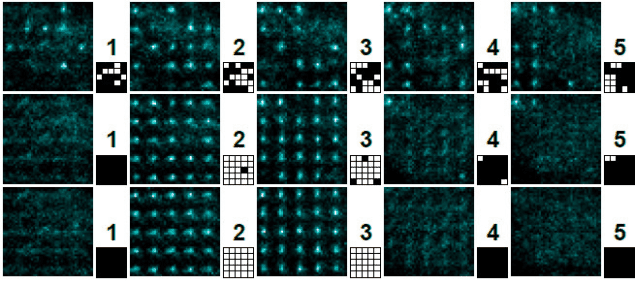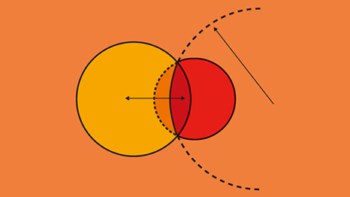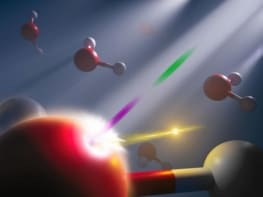
The famous “Maxwell’s demon” thought experiment has been brought to life using lasers to significantly reduce the entropy of a 3D array of ultracold atoms. The work was done by David Weiss and colleagues at Pennsylvania State University who say that such well-ordered arrays of neutral atoms could form the basis of future quantum computers.
Quantum computing continues to be a hot topic in physics because it could lead to the creation of devices that perform certain calculations exponentially faster than conventional digital systems. Scientists are investigating several technologies to create quantum bits (qubits) and among the front runners are arrays of trapped ions held and also superconducting circuits.
The spin states of neutral atoms held in arrays also hold great promise for making qubits. The fact that such atoms have no charge means that large numbers of them can be trapped very close to one another without mutual interference. One popular kind of trap is the optical lattice, which exploits the interference between pairs of laser beams to set up a standing wave that holds atoms at its nodes or antinodes — depending on whether the force is repulsive or attractive.
Engineering interactions
The challenge with neutral atoms is being able to engineer interactions between atoms to establish entanglement – one of the basic requirements for quantum computation. This can be done using a controlled NOT gate, which flips the state of one qubit depending on the state of a second qubit. While neutral-atom systems have been used to make two-qubit gates, the error rates of those gates are higher than the trapped-ion or superconducting equivalents.
Weiss and colleagues’ work is important because they have minimized the entropy of an atom trap, something that will be important for creating high-fidelity quantum gates. This was done by realizing Maxwell’s demon in the lab.
The demon was first proposed in the mid-19th century by James Clerk Maxwell as a challenge to the second law of thermodynamics. The imaginary creature lurks in a pair of gas-filled chambers that is separated by a tiny door. The demon opens the door to allow faster-moving molecules to pass into one of the chambers, and to allow slower moving molecules to pass into the other chamber. Heat is therefore transferred from a colder to a hotter region and the entropy of the system decreases, in apparent violation of the second law.
Rather than sort gas molecules by speed, Weiss and colleagues sorted neutral atoms according to their spatial position. They started by laser cooling a collection of caesium atoms to a few millionths of a degree above absolute zero and then loading them into a 3D optical lattice – made from three pairs of laser beams. Most atoms quickly leave the lattice in such a way that the lattice is left half-full, with each site either empty or occupied by one atom in a random distribution (see figure).
Shifting nodes
The next step is to convert this half-full lattice of randomly positioned atoms into a smaller sublattice that is completely full and therefore entirely uniform. The team was able to see which of the nodes were occupied, thanks to the light from the cooling lasers scattering off the atoms. They then exploited the fact that the standing-wave nodes can be shifted in space by changing the polarization of one of the laser beams in each pair, as well as the fact that this shift occurs in opposite directions for the two spin states of each atom.
The researchers used an additional pair of tightly focused laser beams plus a source of microwaves to selectively flip the spin of any atom in the lattice while leaving the spins of surrounding atoms undisturbed. A change in the polarization of the relevant lattice laser then allowed them to move that atom relative to the others. Repeating these steps numerous times they were able to convert a half-empty 5x5x5 lattice into a completely full 5x5x2 sublattice. This lowered the lattice entropy by more than a factor of two.
Our demon observes the whole system at once instead of one particle at a time, and then acts on it to create a manifestly low entropy state
Aishwarya Kumar
“This process is almost exactly like Maxwell’s demon thought experiment,” says Aishwarya Kumar – lead author of a paper in Nature that describes the work. “The only difference is that our demon observes the whole system at once instead of one particle at a time, and then acts on it to create a manifestly low entropy state.”

Engineered atomic arrays for quantum computers
Kumar says their experiment does not violate the second law of thermodynamics. Indeed, it was realized in the mid 20th-century that Maxwell’s demon would actually increase the overall entropy in the universe as a result of sorting the gas molecules. Likewise, he says, in their experiment the entropy goes up when cooling photons randomly scatter off atoms – which the team exploited to see the atoms. He adds that the group’s next step is to entangle the qubits with high fidelity
Ronald Hanson, who investigates diamond-based “spin qubits” at the Delft University of Technology in the Netherlands, is impressed with the latest work but is reluctant to discuss its implications for quantum computing. “This is first and foremost a beautiful physics experiment,” he says. “Comparing different quantum computing experiments is not so easy and often subjective as the potential paths to scalable technologies are very different.”



